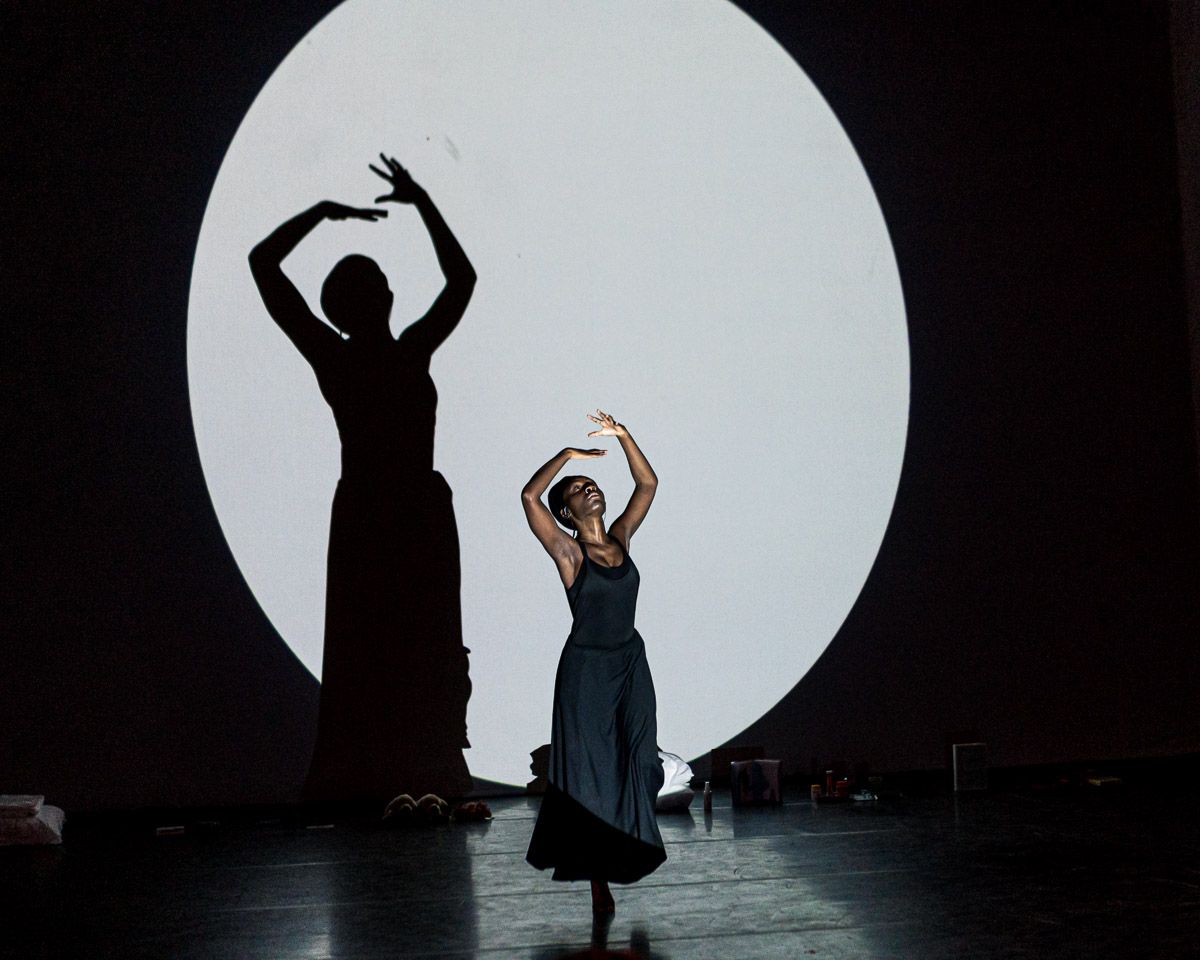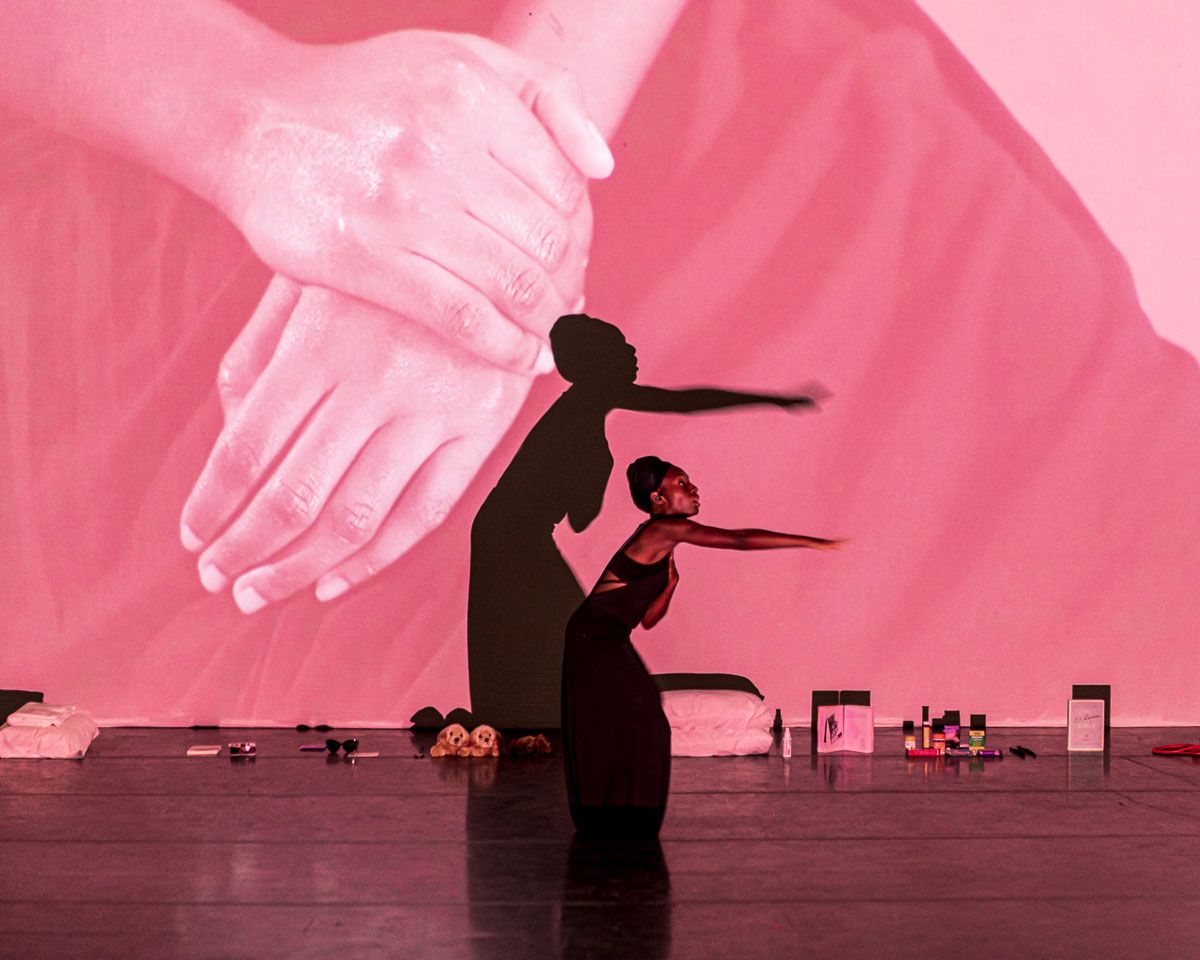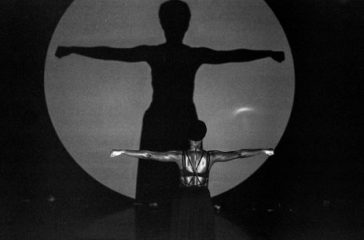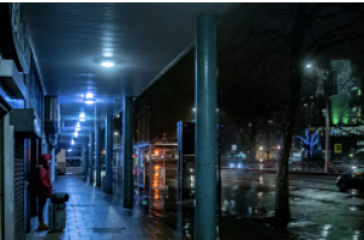She is poised. She commands attention, in her readiness, and in her attention to us.

She has been arranging objects on the floor in a wide curve by the screen behind her. The instruction on the screen asks us to notice, to pay attention to the mover, pay attention to ourselves, pay attention to what is happening in our bodies. There are chairs and floor cushions. We can sit where we like, how we like, and are invited to express what we feel in the moment; paper and pencil are provided to do so. The line of objects: a monitor with changing images; a pile of books, popular but serious books about self-healing and its intersection with a specifically Black and female political reality; objects of comfort, pillows, cuddly toys; objects of reflection, a locket, a journal, a camera. A horrifying object of discomfort, a pristine scarlet rawhide whip. I’ve recently seen a viral photograph of a blood clot in the shape of the lung passages that coughed it up: the coiled whip, with its forked ends, reminded me of this, along with other things.
She is poised. She commands attention, in her readiness, and in her attention to us. She looks at the audience and takes time to make eye contact with several people. Silently she establishes the invitation, and that welcome is supportive of us, the audience.
This artist with the body of a dancer wears black, a long skirt over leggings and a leotard. Her head is bound in a head tie, minimalist like the rest of her costume. The light of the projector casts her blank shadow on the screen behind her slightly larger than life, a heroic, archetypal version of her Self. She appears balanced, strong, in control and superbly expressive. This is so in contrast to the main theme of the performance it invests the whole thing with a knotty cognitive dissonance, establishing a pervasive interpretive puzzle. In this performance, an existential sense of splitting, damage and confusion is the source that generates the invitation to heal, and it is performed with imposing, deeply charismatic self-possession. This is disturbing. It’s also very very active: it forces in the audience a kind of openness to interpretations which may remain unresolved.

She moves to a soundscape punctuated by percussive taps and bass notes, and abstract vocalisations. Interviews recorded with Black women recovering from trauma accompany some of her movement. Sometimes the screen behind her shows projected details of her body in monochrome against backgrounds in solid colour, the colour changes to match the theme of the current movement and the body part it originates in: matt red, green, pinks and purple. Other times the spotlight casts her shadow behind her, an enhanced but just about separate character in this drama. Sometimes she looks desperate and exhausted, and struggles to catch her breath, or her back seems to fight against unbearable weight. She enacts a struggle to breathe and vocalise, then running, escaping. There is a long sequence of hand wringing. There are movements of expelling from the body, of hauling something out of herself. There are attitudes of conserving, of self-protection. The voices describe pain. And there are movements of recovery.
What is being communicated comes to a resolution and a stillness as the artist invokes multiplicity, community and healing in a final tableau of shadows and presence. The work has been meticulously constructed, full of heart and honesty, dazzling in the display of skill and bodily control; and full of artifice, that is, the rigorous artistry and process of making.
The way she looks, her gestures, her costume, her subject matter, the way she moves, her language: all connect her to a body of work I have seen developing over the past few years by young diaspora Black women artists, which work is itself partly built on a foundation of historical performance research, and reclamation, by Black performers over decades. Lived experience is of course the other part of this foundation. It is as though an idiom and language are being developed, or being uncovered, or being formalised, or all of those things: a vernacular of diasporic practice expressed in body and gesture.
It is about more than gesture: where the body bends, is at the hips. Where the back is straight, it is also mobile. Feet connect to the ground with power, conveying a sense of hard-won rootedness. It is a vernacular that establishes particular historical resonances: a shared history and common language with deep roots in dispossession, in agony; in reclamation and recovery, continuity and survival.
-
About Osunwunmi
Folake Shoga is a Nigerian/British artist working out of Bristol, using among other things moving image and sculpture and drawing. Folake has been exploring both practice and critique in Live Art and sometimes writes under the name Osunwunmi, a name that invokes the Yoruba Orisha as exemplar and as inspiration. She is In Between Time’s Writer in Residence.
Folake was a member of In Between Time’s Creative Exchange Lab.
Explore more work:
Reflections on We Are Warriors
Osunwunmi reflects on At the Ends of The Day by Mamoru Iriguchi
Images at Tramway/Dance International Glasgow 21 @stillmotionarts








